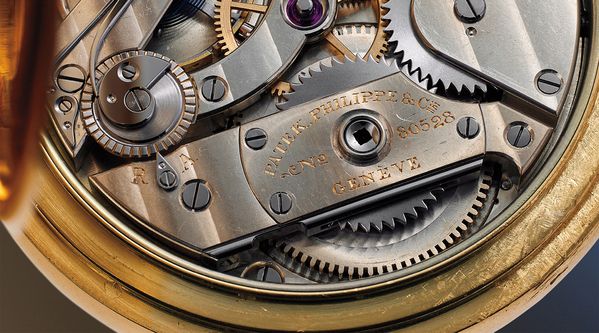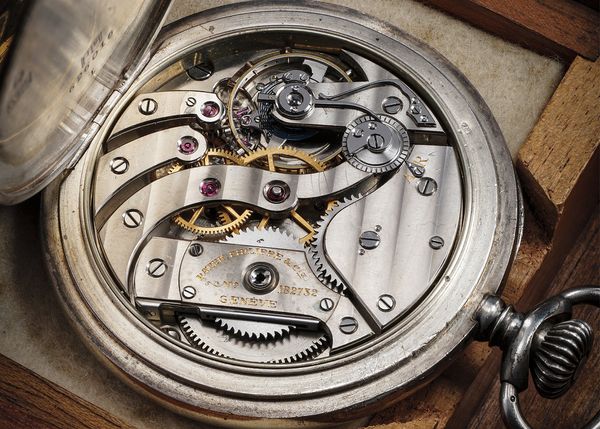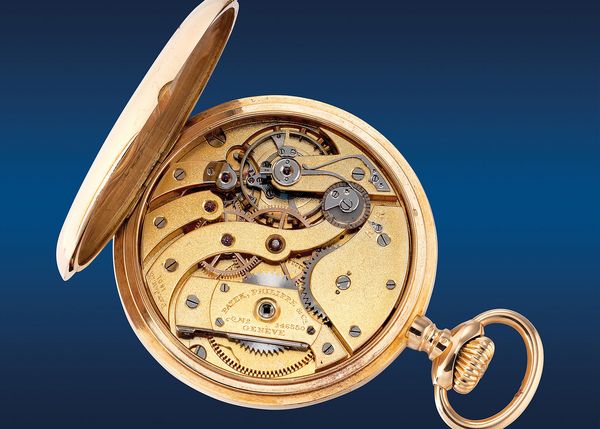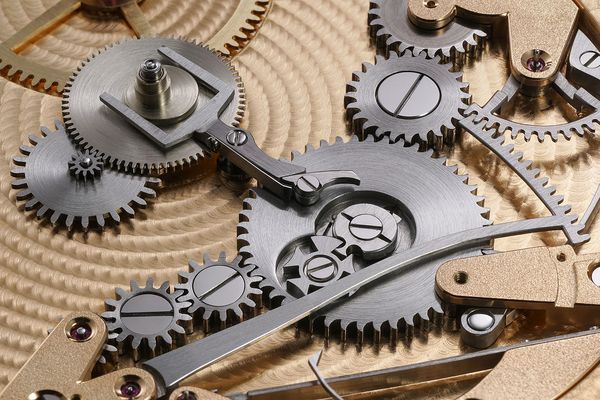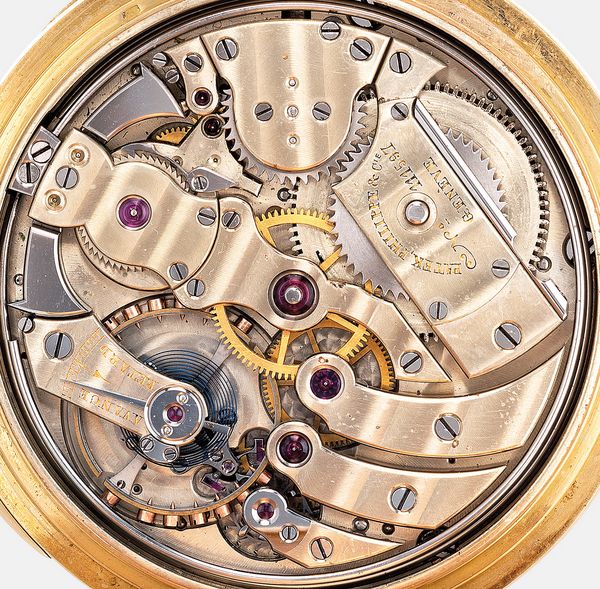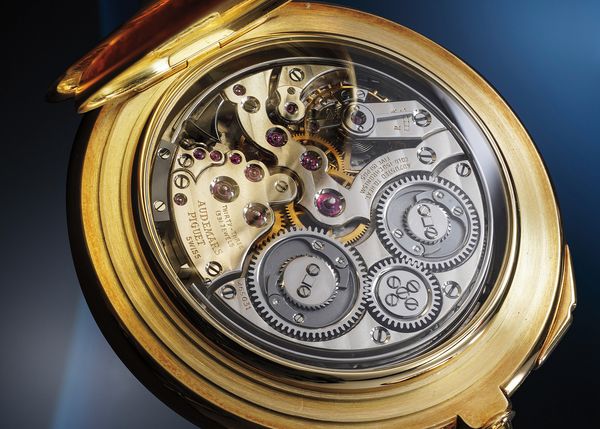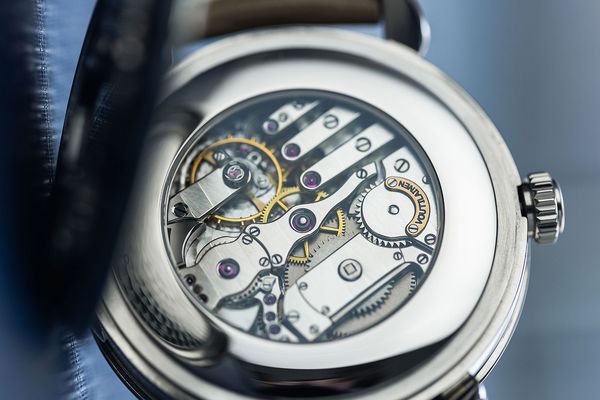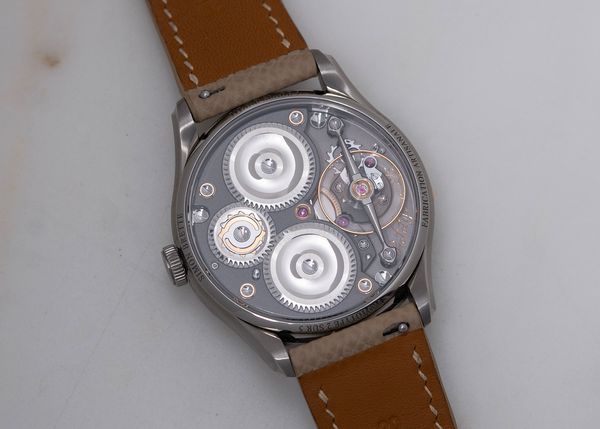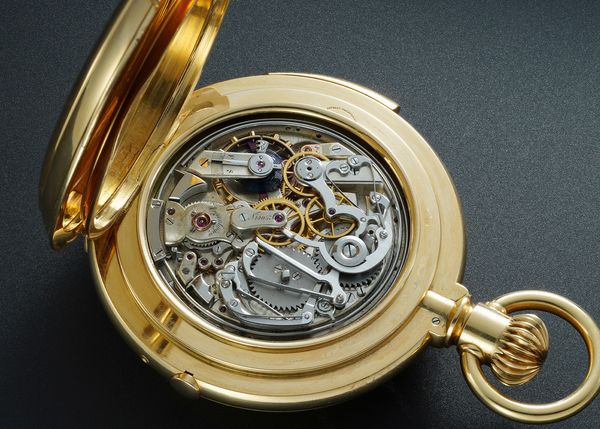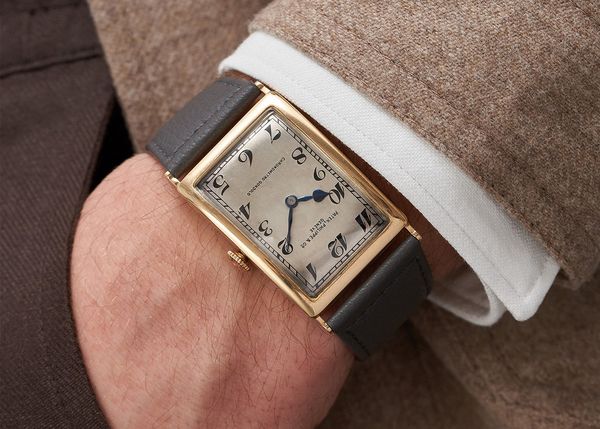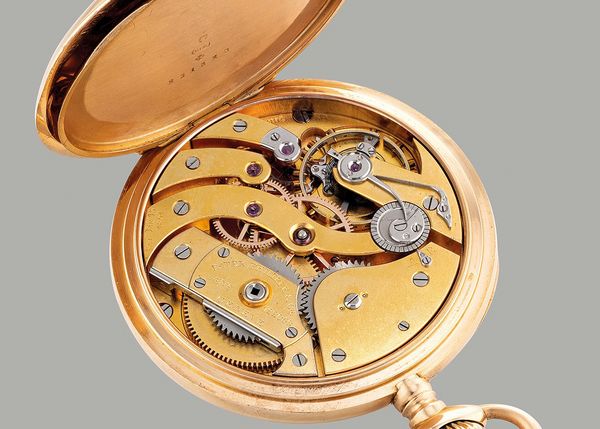– Logan Baker
I joined the Phillips in Association with Bacs & Russo team just over a year ago.
I had previously worked exclusively on the media side of the watch industry; at names you might know, like Hodinkee and WatchTime.
Phillips is my first job in the auction world, so I spent much of 2023 getting my bearings and learning the ins and outs of one of the auction business.
I also spent the year with my nose set firmly down, wanting to learn as much as I could about the hundreds of watches that appeared in all our catalogs and auctions, while also attempting to keep up with all the new releases coming from the mainstream side of the watch world.
I noticed a rather nerdy trend that emerged on both sides – I couldn’t go a few months without hearing about a timepiece using an esoteric mechanical gearing approach known as “wolf’s teeth.” Yes, as in the teeth of a gear, sharpened and executed in the shape of canis lupus chompers. Who says watchmakers aren’t a creative bunch?
Wolf’s teeth gearing had its highest profile moment of 2023 on the ratchet and crown wheels of the Chronomètre Artisans wristwatch, the debut creation of new independent watchmaking sensation Simon Brette.
Brette and the Chronomètre Artisans ended up taking home the prestigious Horological Revelation prize at last year’s Grand Prix d'Horlogerie de Genève (GPHG), but he wasn’t the only new face on the block that opted for wolf’s teeth in 2023.
Hervé Schlüchter, a protege of the one-and-only Philippe Dufour, also made the choice on the winding wheels of his debut l’Essentiel Regulator wristwatch.
Two occasions does not a trend make, but I also noticed wolf’s teeth gearing showing up in quite a few of Phillips’ most important lots of 2023, including the “Imperial Patek Philippe,” a 1937 Calatrava ref. 96 “Quantieme Lune” wristwatch previously owned by Aisin-Gioro Puyi, the last Emperor of China’s Qing Dynasty, and that sold for $6.2 million USD, in May 2023, as well as on the ratchet wheel of the Philippe Dufour for Audemars Piguet Grande et Petite Sonnerie Pocket Watch No.1, which sold for CHF 889,000, at the Phillips Geneva Watch Auction: XVII, in May 2023.
I even noticed it inside the Naissance d’Une Montre 1, a wristwatch I was able to handle while working on a story covering that watch’s sequel, the Naissance d’Une Montre 2, which sold at Phillips Geneva for CHF 406,400, also in May 2023.
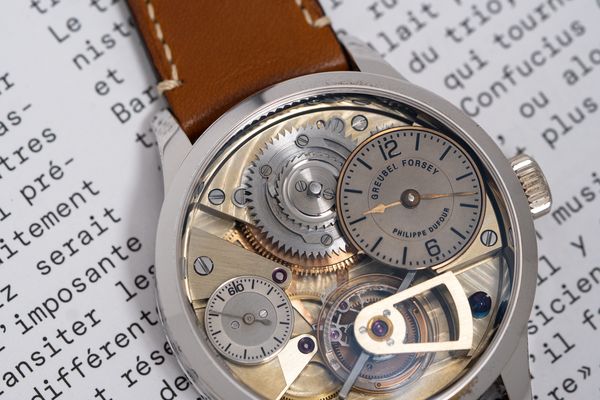
Wolf’s teeth then showed up inside one of the coolest – and most expensive – watches sold by Phillips PERPETUAL last year, the one-of-a-kind Voutilainen Decimal Repeater GMT “L’Esprit du Bois” wristwatch. And then finally, wolf’s teeth was there once again inside the Urban Jürgensen Oval Tourbillon Pocket Watch by Derek Pratt, the highlight of our November 2023 non-selling exhibition, dedicated to the 250th anniversary of the Jürgensen family watchmaking dynasty.
“I remember back in the old days pocket watch collectors would show me a watch with wolf’s tooth," says William Massena, the former managing director of TimeZone and the current proprietor of the Massena LAB concept studio and watch brand. "But it would just happen en passant. I considered it to be just another element of finishing, similar to chamfering on a movement.”
Maybe I’m finding a pattern where none exists, but those six occurrences seemed significant to me. Wolf’s teeth could all of the sudden be found inside one of the most-discussed new wristwatches of the year (the Simon Brette Chronomètre Artisans), the most expensive timepiece sold at auction of the year (the Imperial Patek Philippe), and in the Audemars Piguet Grande Sonnerie No.1 by Philippe Dufour, the second-best pocket watch auction result of the year (after the Roger Smith Pocket Watch No. 2).
All three of these timepieces come from vastly different eras of watchmaking history, with more than four decades in between each one, and come from the workshops of vastly different makers. Wolf’s teeth gearing was also already rare in all three of those decades (1930s, 1980s, 2020s).
So what’s the deal? Is wolf’s teeth a cheat code for making a desirable watch, regardless of era? And does the wolf’s teeth shape actually do anything compared to normal gear teeth, or is it just for decoration?
I’ve got the answers right here.
First, A Primer On Mechanical Gearing
A mechanical watch is nothing without its wheels and gears.
The keyless works, the crown wheel, and the ratchet wheel are all used to wind the watch and to keep it wound. The going train (typically comprised of at least a center wheel, a third wheel, and a fourth wheel) transfers the watch’s stored energy reserve to the escape wheel (part of the escapement) that’s connected to the pallet fork), which dispenses the energy by beating multiple times per second. The motion works are another gear train that carries the hour and minute hands, enabling the complete rotation of the minutes hand (once per hour) and the hour hand (once per 12 hours), and connecting with the keyless works for hand setting.
Let’s explore the typical going train here for a moment.
The center wheel (also known as the second wheel) is driven by the barrel and rotates once per hour; it also drives the motion works. Further down the train, the fourth wheel drives the escape wheel and completes a rotation once per minute; it can drive a small seconds display if needed. The third wheel, meanwhile, drives the fourth wheel pinion and is in between the center wheel and the fourth wheel, allowing for a gear ratio of 1/60 to develop, due to the rotational speed of the center and fourth wheels.

A gear ratio basically refers to the required mathematical formula that reveals how many times a gear must turn to allow another next gear in the sequence to turn a single time. (In more precise terms, that means the ratio between the output torque and the input torque is equivalent to the ratio of the diameter of the output gear to that of the input gear. Meanwhile, the ratio of the output rotational speed to the input rotational speed is equivalent to the inverse of the ratio of the diameter of the output gear to that of the input gear.) In other words, the fourth wheel completes 60 rotations for every single rotation of the center wheel, resulting in a gear ratio of 1/60 for the going train.
The gears of a gear train are connected sequentially to one another in a process called meshing, where the individual external “teeth” of every gear meet. When gears of differing diameters mesh, it results in three things: a shift in torque, a reciprocal change in the gears’ rotational speed, and an inverse physical rotation of the gears in the opposite direction of one another. The most efficient transmission of torque between two gears occurs when the opposing teeth roll against each other rather than slide, resulting in the least amount of friction between gears. If the teeth don't mesh properly, friction builds up, wearing the gears away over time.
If the gear ratio effectively determines the number of gear teeth and the diameter of each gear, how are the size of the gear teeth determined?

That’s based on the pitch circle of each gear.
A gear pitch is the distance between two identical points on a pair of adjacent gear teeth (see below image); the pitch circle is the total circumference of the gear, measured approximately halfway between the base and the tip of the teeth. The diameter of the gear measured using the pitch circle's boundary can then be used to determine the tooth thickness, the pressure angle, and/or the helix angle. The latter two are critical in establishing the direction of force and the amount of torque exerted between meshing gears, as well as to ensure the gears mesh without slippage. The teeth of every gear are created to be proportional with the diameter of the pitch circle.
That’s a very brief, surface level explanation of the most important wheels and gears to know in a conventional mechanical watch. Yes, surface level. There are a huge number of mathematical equations that watchmakers must perform in order to develop a mechanical movement. And all we covered above were the gearing basics for a two-handed watch with small seconds. Any additional complications or functions are typically appended via additional gears or gear trains connected to the going train.
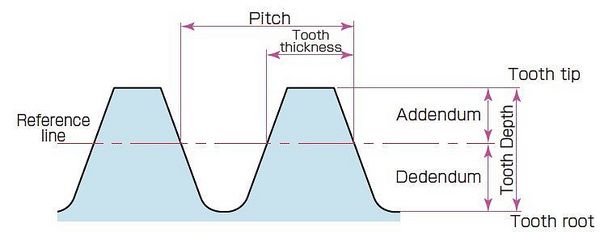
The difficulty in developing your own gear trains is why we so often see watchmakers and brands borrow successful designs from existing movements, even if they've developed every other part of a watch themselves. It’s also why most watchmakers employ micromechanical engineers as part of the movement design process to identify any potential issues in advance. More and more watchmaking schools are offering courses and specialized degrees for the engineering side of the business.
If it takes all that work and precision to create watch gearing with conventional, symmetrical gear teeth (known as involute or cycloidal), what sort of benefit could asymmetric gearing with a “wolf’s teeth” design offer a watchmaker that would be worth the extra production trouble?
The History Of Wolf’s Teeth Gearing
Jean-Antoine Lépine is the first watchmaker credited with using wolf’s teeth gearing, appearing in his work for the first time in 1771. It’s likely he began using the technique based off a hunch.
“The idea back then was that this tooth profile would theoretically be stronger than other tooth profiles,” says Nicholas Manousos, watchmaker and Executive Director of the Horological Society of New York (HSNY).
“Wolf's teeth was used in the past to produce stronger teeth because the root of each tooth was much larger,” independent watchmaker Kari Voutilainen adds. “This is the reason why winding gears sometimes had them. Teeth often had a square-shaped root in the past, which was sort of weak; by making this wolf teeth shape, the root is larger, meaning it won’t break as easily compared to traditional teeth.”
In more technical terms, a wolf's tooth consists of an epicycloidal addendum on one side of the tooth, with either a straight or slightly concave curve on the opposite side of the tooth tip. It's what makes the gear teeth look like actual teeth. The teeth on the separate wheels will mesh when the individual tips reach inside one another's pitch circle. This is different from standard gear teeth in a watch, such as cycloidal, where the driving gear acts as a pinion.
"There are two different things that we care about involving the pressure that we put on the gears," Simon Brette says. "You have the individual contact point with the gear wells, and then you have to find the right diameter. It shouldn't be too big because you will have lots of friction, but it can't be too small because they will break easily and more often. If the diameter is bigger, then you have less pressure; however, the bigger it is, the more friction you have, so you'll end up losing lots of torque. It's a compromise between pressure and friction. Pressure will damage the teeth, and friction will cause you to lose energy."
Lépine utilized wolf’s teeth gearing off and on for the next two decades, almost exclusively favoring it on his production pocket watches produced between 1787 and 1789. However, by the end of the following year, his use of wolf’s teeth gearing had died out completely. There’s no record of any Lépine watches with wolf’s teeth appearing after 1790.
Adople Chapiro, in his seminal 1988 book on Lépine (Jean-Antoine Lépine, Horloger (1720-1814), les editions de l’amateur), theorizes that any potential benefit of wolf’s teeth gearing (les dents de loup) wasn’t worth “the delicate work of the size of the wheels.”
Although Lépine abandoned the technique, it was revived in the 19th century by a number of makers, including Switzerland’s Jean-Adrien Philippe (yes, of Patek Philippe), Louis Audemars (of Audemars Piguet), and Charles Antoine LeCoultre (of Jaeger-LeCoultre), and England’s Charles Frodsham, Benjamin Vulliamy, and Edward John Dent.
Jean-Adrien Philippe utilized wolf’s teeth gearing in his first attempts at creating a stem-winding and setting system, beginning in the early 1840s. These early watches and movements from Jean-Adrien Philippe technically predate his associations with Franciszek Czapek and Antoni Patek, meaning wolf’s teeth gearing has been a part of Patek Philippe’s identity from its very start. IWC also notably used wolf’s teeth gearing on its high-grade Calibre Jones found in pocket watches starting in the 1870s.
Patek Philippe pocket watches can be found using wolf’s teeth gearing throughout the mid-19th century to the early 20th century. Even early Patek Philippe wristwatches that utilized LeCoultre ébauche movements, such as the Imperial Patek Philippe and other early ref. 96 pieces, utilized wolf’s teeth gearing. It’s likely that the movements used in these initial attempts at a wristwatch were modified pocket watch calibers, rather than movements purposely built for a wristwatch. The use of wolf’s teeth gearing is most associated with Patek Philippe pocket watches and wristwatches in the high-grade Chronometro Gondolo family.
"The first thing I think of with wolf's teeth, from the Patek Philippe perspective, are the Chronometro Gondolo watches," says John Reardon, a vintage Patek Philippe expert and the founder of Collectability. "It was a standard feature in Gondolo pieces. It's always been a sign of quality, as well as a curiosity for collectors. When I was in the auction world, I made sure to point it out to people; it would always resonate. It's considered a part of the Patek Philippe DNA."
Later on, in the early 20th century, American watchmakers such as the Keystone Howard Watch Company would use wolf’s teeth gearing as a symbol of quality in their highest-grade pocket watches.
"It was a special quality marker," says Helmut Crott, collector, former auctioneer, and member of the advisory board for Phillips in Association with Bacs & Russo. "I'd make an additional note of it in the catalogs I worked on. It was quite unusual."
The use of wolf’s teeth gearing declined as the wristwatch gained popularity in the middle of the 20th century. Then, in the late 1980s and through the 1990s and 2000s, when collectible high-end watchmaking began its full-fledged revival after the Quartz Revolution, wolf’s teeth gearing made an unlikely comeback. Philippe Dufour utilized wolf’s teeth gearing in the Grande Sonnerie pocket watches he built for Audemars Piguet in the 1980s, as did Derek Pratt inside his famous Oval pocket watch produced for Urban Jürgensen, which he began work on in 1982 and didn’t complete until 2005 (with the assistance of Kari Voutilainen).
Antoine Preziuso is one of the first contemporary independent watchmakers to utilize wolf’s teeth gearing inside a wristwatch, with the release of his Tourbillon in 2000. Roland Murphy, of Pennsylvania’s RGM, offers wolf’s teeth gearing as an option inside his 801 series of in-house movements. Arnold & Son has used the technique in its TBTE Tourbillon and TES Tourbillon collections, and it can be found in various Kari Voutilainen wristwatches, including examples of his Observatoire and the Decimal Repeater GMT “L’Esprit du Bois.” Not to mention the Naissance d’une Montre 1, a wristwatch built by French watchmaker Michel Boulanger with guidance from Stephen Forsey, Robert Greubel, and Philippe Dufour.
A non-comprehensive list of 2000s and 2010s era wristwatches using wolf’s teeth gearing can be found below.
Audemars Piguet Millenary Deadbeat Seconds, 2006
Romain Jerome Master Tourbillon, 2006
F.P. Journe Centigraphe, 2007
McGonigle Tourbillon 2007
Bernhard Zwinz Calibre R, 2009
Hajime Asaoka Project T Tourbillon, 2009
Rebellion REB-5 Tourbillon, 2011
Urban Jürgensen Unique Piece Tourbillon Minute Repeater Regulator, 2014
Greubel Forsey Signature 1, 2016
Armin Strom Mirrored Forced Resonance, 2016
Louis Moinet Memoris Chronograph, 2016
Leica L2, 2018
All of this leads us to last year, 2023, when Simon Brette and Hervé Schlüchter both burst on to the scene with exciting new wristwatches that made a specific point in highlighting the use of wolf’s teeth gearing. It’s a curious development. A bygone watchmaking technique discarded by its inventor over 230 years ago is now being used by some of watchmaking’s biggest up-and-coming stars.
The question is why.
The Why, And How, Of Wolf’s Teeth Gearing
"What I really wanted for my brand was to take the best techniques, the best things I loved from 19th-century watchmaking, and to put them in my watch," says Simon Brette. "The appreciation I have for wolf’s teeth is because it makes me think of Lépine, who I consider to be one of the best watchmakers of the 19th century. Wolf's teeth means very high quality. That's the feeling I have when I handle pocket watches with wolf’s teeth."
We've established that wolf's teeth gearing connotes a certain level of quality. French, Swiss, British, and American watchmakers from the 18th to the 20th century all used it to symbolize a higher standard of watchmaking. This implication of quality is wolf's teeth defining characteric – you can't separate the two – but the question of whether there is any true mechanical or chronometric benefit to go along with this suggestion is a lot more nebulous.
"The short answer is no, it does not have any benefit, any mechanical advantage," says Manousos, the watchmaker and HSNY director. “As far as I can tell, there was no actual research or testing done to verify any benefit. It was just a theory Lépine went with. And today it’s a byproduct of the watchmaking experiments that happened quite often in the 19th century. They look cool, but that's pretty much it. Even if there was some kernel of truth to it, the effect would be so infinitesimal that it still wouldn't make sense to use given the added complexity in manufacturing them."
Manousos compares wolf's teeth gearing to the use of moustache levers in 19th- and 20th-century pocket watches. Moustache levers were a type of escapement that developed in the 18th century as an evolution of the traditional lever escapement; they could be found in various high-grade pocket watches of the time, especially from Patek Philippe. The lever – which, yes, resembles the facial hair – was thought to provide better functionality by providing greater balance to the pallet fork.
In actuality, the added weight of the moustache lever proved to result in more of a functional disadvantage, eventually leading to its disuse. Moustache levers are even rarer than wolf's teeth gearing today, although Hervé Schlüchter did make a point to include them in his debut l’Essentiel wristwatch. However, unlike moustache levers, there's no theoretical disadvantage to using wolf's teeth gears over more standard gear shapes, like involute or cycloidal designs.
The most common finishing techniques used in fine watchmaking are dual purpose. They both look nice and offer some sort of practical benefit. Heat-blued screws are both attractive and prevent oxidation over time. Côtes de Genève and perlage are a charismatic alternative to a raw metal plate or bridge, while allowing watchmakers to obscure imperfections that might occur during assembly or repair.
The attractiveness of wolf's teeth gearing is as undeniable as it is wholly impractical. Therein lies the primary reason wolf's teeth remains rare in today's wristwatches – they can't be finished using CNC machines.
"You can't finish wolf's teeth with a CNC machine," Brette says. "Most gears are two dimensional, you cut them into a dimension. But if you want to go deeper and have these wolf's teeth bevels like in the past, it's a very long process to make them more beautiful. You have to make sure the gears remain efficient while also caring about beauty and aesthetics. It can be very tough to find the perfect in-between, the perfect compromise between efficient and beautiful. This is another challenge when you design something, you have to care about the technical aspect, but you also have to care about the aesthetic because, for me, it's something that you cannot miss."
For the Chronomètre Artisans, Simon Brette had to find the exact size and shape of gearing that would work for the movement. There was no ébauche that allowed him to reproduce a gear train; he used his background as a movement engineer to develop the exact gear dimensions required for his movement. He then had to work with his supplier network to develop new tooling to cut the teeth for the gears.
"There are no readily available cutters for wolf's teeth," Manousos says. "You have to make your own cutter to be able to make them."
That's a substantial investment. Gear teeth can theoretically come in countless shapes and sizes, depending on what a movement requires, but the reason we see so little innovation in gearing is because involute and cycloidal shapes have been standardized for so long. The tooling to cut those shapes is so commonplace that most suppliers and brands would never venture off the beaten path to develop new tooling that could only be used for one set of teeth. There's also so little demand from collectors and clients of brands to see new forms of gearing – so watchmakers don't see a reason to invest in something that so few end consumers care about.
"I think the reason why we don't see a whole lot of innovation in teeth profile is because it's not something that consumers really care about too much," Manousos says. "It's a very small detail. It's hard to understand the differences between tooth profiles. The exception is a wolf's tooth because you can look at it and easily see that it's different."
The dollars and cents of it all make complete sense from a brand perspective, but I think it's more of a chicken and the egg situation. Is it more likely that collectors aren't aware they have the option for gearing that's more attractive than the standard involute and cycloidal shapes, or is it that they simply don't care? Watch enthusiasts tend to be some of the most detail-oriented and passionate individuals in any collecting field, so I think the latter is a much more likely assumption.
"Most of today's watchmakers take gearings from another movement to be sure that it's well designed," Brette says. "I really wanted to create something from a blank page using what I've learned about the past. It's all about my point of view when I design something. That's why I decided to come out with my own watch under my own brand. I wanted to come up with something new. It doesn't make sense to use wolf's teeth today if you care about margin or price."
The crown wheel of the Chronomètre Artisans actually proved to be one of the most complex components in Brette's debut movement, requiring three different types of gear-cutting: wolf teeth's, vertical teeth, and then internal teeth. The ratchet and crown wheels also have to be thicker than usual to connect with the wheel pinion within the crown.
"The reason why other watchmakers don't use wolf's teeth anymore is due to the amount of time required to cut these gears," says Brette. "It can only be achieved using the old technique. Today's normal gears are flat, radial, and symmetrical, which can be cut in few seconds, but we had to develop new techniques to cut my wolf's teeth. It's more than just an aesthetic choice. It's about the spirit of watchmaking, about not caring to make something the fast way to keep the price low. But it won't change anything from a normal movement because we have exactly the same profile. It'll be exactly the same level of transmission, only the techniques and the design change."
Simon Brette says he'll continue to use wolf's teeth in his watches going forward, and that he hopes it becomes a recognizable part of his identity as a watchmaker.
Final Thoughts
The question of the real or imagined value of wolf's teeth is an important one for today's collectors. What's old is new again, and horological techniques once abandoned are now embraced.
Today's watchmakers are smart and experienced enough to understand why wolf's teeth was seemingly abandoned by Lépine and others. But some of them are also determined and passionate enough to embrace wolf's teeth (and other elements) the same way their predecessors once did. It's a romantic approach that highlights the craftsmanship of watchmaking and a love for history, laying bare to the same reasons we, more broadly, continue to appreciate mechanical watchmaking over smartwatches.
"I still remember the first time I wound a pocket watch with a wolf's teeth winding system," Reardon says. "It was a ladies' pendant watch from the 1880s, with an enamel dial and a beautiful, beautiful case. When I wound that watch for the first time, it was magical, the way the click had a sound. I love winding those watches, especially when you can actually see the movement and the turning of the two wolf’s teeth wheels. It's all about the sound and the experience – and the aesthetic is second to none. Anytime we can bring that feeling back – the emotion and the experience of traditional watchmaking – is a wonderful thing. It's something I hope we see more of in the future."
About Phillips In Association With Bacs & Russo
The team of specialists at PHILLIPS Watches is dedicated to an uncompromised approach to quality, transparency, and client service. Phillips in Association with Bacs & Russo holds the world record for the most successful watch auction, with its Geneva Watch Auction: XIV having realized $74.5 million in 2021. Over the course of 2021 and 2022, the company sold 100% of the watches offered, a first in the industry, resulting in the highest annual total in history across all the auction houses at $227 million.
About Logan Baker
Logan has spent the past decade reporting on every aspect of the watch business. He joined Phillips in Association with Bacs & Russo at the start of 2023 as the department's Senior Editorial Manager. He splits his time between New York and Geneva.
Recommended Reading
Meet Simon Brette, The Fresh-Faced Frenchman That Has The Swiss Watch World Buzzing
Year In Review, 2023: Phillips In Association With Bacs & Russo
A Technical Overview Of Philippe Dufour's First Pocket Watch
